2010 Saab 9-5 – Click above for high-res image gallery
A funny thing happened on the way to bankruptcy court for General Motors. As part of a bid to have its red-stained slate wiped clean, it moved to divest itself of a number of brands in its bloated portfolio, with Pontiac, Saturn, Hummer and Saab all earmarked for sale or closure. However, only one brand inspired sufficient passion among both owners and those with the financial wherewithal to rescue it from GM's 'wind-down' apple polishers. Oddly enough, it was the tiny Swede that successfully swam out to the life raft. Saab, the marque with the smallest and oldest product lineup, lowest volume, and the poorest brand recognition among American consumers somehow found a way to survive.
How, exactly, did this come to pass? For starters, unlike any other of GM's death-row divisions, owners and fans rallied in dozens of countries, urging anyone who listened to "Save Saab." Now, we're not naïve enough to think that a band of loyalists were all it took to change the course of automotive history, but it's telling that there were no pitchforks and torches – or even a handful of picket signs – produced over the axing of the other brands. Saab remains a seldom understood, much loved brand, and we know that the displays of unity from Saab's scorned faithful stoked the fire of unlikely suitor Victor Muller, CEO and owner of Spyker Cars, as his team waded through a stomach-churning series of negotiations. After watching from the sidelines while bids by other small automakers and investment groups fizzled, the Dutch businessman and his team eventually pried the battered brand away from GM – but not before Saab had been partially liquidated.
While Muller clearly has an affinity for the Swedish marque, he insists it wasn't boyhood sentiment that drove the purchase – it was the company's robust Trollhättan operations and a raft of promising, almost-here product that pushed his team to persevere. That stream of shiny new tin begins with the car you see before you: The 2010 9-5. Click through to the jump to see if Muller and Company have good reason to be optimistic.
Photos by Chris Paukert / Copyright ©2010 Weblogs, Inc.
During our trip to Gothenburg, Sweden to drive the new 9-5, representatives vigorously pointed out that their new sedan positively brims with "Saabishness" despite being developed entirely under GM's corporate umbrella. We had to wonder: Could the same Detroit decision-makers that gave us the half-hearted Subaru-based 9-2 and the utterly cynical Chevrolet Trailblazer-in-drag 9-7X actually know enough about the brand to deliver a competent and authentic 9-5 as a parting gift to its new owners – a Saab Saab? As it turns out, yes.
As Muller told us, GM finally started to 'get the picture' with Saab in 2005, back when it decided to develop the stunningly canopied Aero X coupe. Despite never making it to production, the arresting 2006 concept (only the second showcar in Saab's entire history) actually gave Saab a much-needed fresh design direction, the production adaptation of which can be clearly seen in the new 9-5.
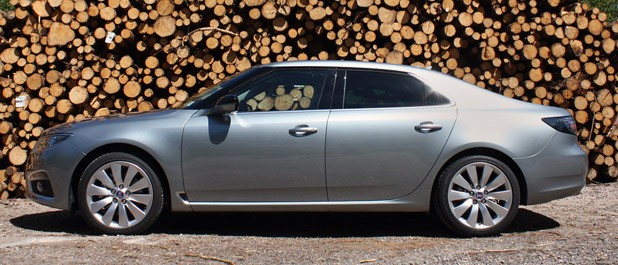
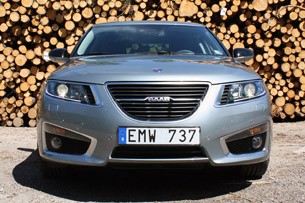
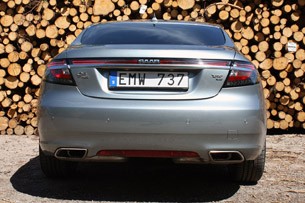
While the 9-5 doesn't have the Aero-X's jet-inspired tilting canopy, clear acrylic gauges or its novel drawer-style trunk, it does have an expressive, modern design that's extremely slippery (.28 cD). Its face is clearly evolved from the Geneva concept, along with details including blue-tinged 'ice block' lighting, turbine-style alloys, and blacked-out A pillars that lend the windshield a similar wraparound look. More traditional Saab cues including the 'hockey stick' greenhouse surround and prominent C-pillars also make the scene. Overall, it's a deeply handsome set of clothes that we think will wear the years particularly well because it doesn't rely on fussy surface development, tacked-on aero addenda or a lather of chrome.
Make no mistake – this is a very big car whose clean design helps it hide its bulk. At 197.2-inches long, the 9-5 shadows its chief rival, the Audi A6, by nearly four inches, and it's more than four inches longer than BMW's new 5 Series. Dimensionally, the closest comparison we can draw is actually to the Buick LaCrosse, which is predictable because they both ride on long-wheelbase derivatives of GM's Epsilon II architecture, the basic platform of which also underpins the Opel Insignia and Buick Regal (albeit in a shorter form).
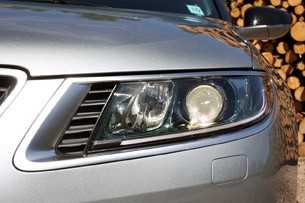
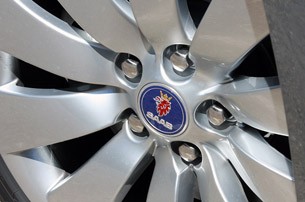
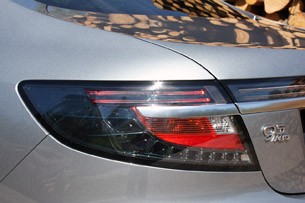
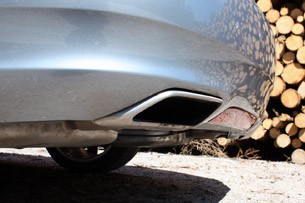
Despite shared architectures and similar drivetrains, the 9-5 looks, feels and goes down the road in a wholly different fashion than its TriShield relatives. Indeed, sampled back-to-back, you'd probably be hard pressed to find much common ground. That's not a knock on any of the models in question, but instead a testament to the efforts of both Saab's stylists and its engineers. Perhaps we shouldn't be terribly surprised – GM made sure that the Scandinavian team had considerable input into the dynamics of the entire Epsilon II family, an assignment that apparently gave technicians the proper perspective to ensure adequate differentiation and, well, Saabishness.
That coherence may start with the exterior, but it carries over into the 9-5's cabin, which is unlike anything else in GM's stable. Traditional Saab cues like a driver-centric dashboard, joystick-toggled eggcrate vents, green instrument lighting, and a console-mounted ignition (now push-button instead of key-based) are all present and accounted for, as is a nifty new round information display nestled in between the analog tachometer and speedometer. The latter can display everything from trip mileage to speed limits to an amusing altimeter-style speed readout that's more fun than functional.
There's even Saab's excellent 'Night Panel' function that extinguishes all non-essential gauges for distraction-free nighttime driving – something that's particularly welcome now that there's an eight-inch screen in residence. Unfortunately, the Night Panel switch looks exactly like other automakers' start buttons in both form and location, and while that won't be a problem for owners who spend a few weeks with the car, it's an ergonomic snafu likely to haunt the unfamiliar.
More praiseworthy are the center stack controls and the easy-as-pie touchscreen infotainment unit. The buttons and knobs are all logically arrayed, and we're quite pleased that Saab has avoided the temptation to fit an all-in-one controller like those popularized by German rivals. One thing that is remarkably Teutonic in feel, however, is the 9-5's somber dashboard. Particularly on the doors and in front of the passenger, there really isn't enough to hold one's interest in terms of trim. We're not advocating for wood (we hear a grain package will be available, however), but something to break up the darkness would help make the interior feel more premium, be it piano black or some sort of additional aluminum trim.
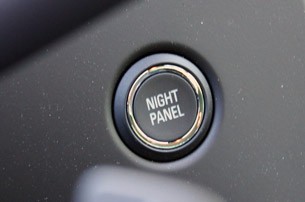
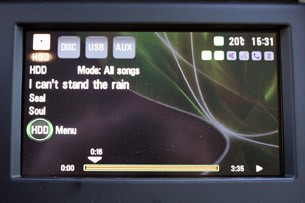
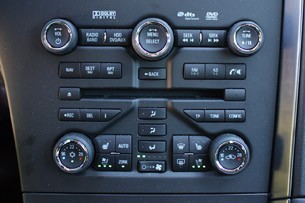
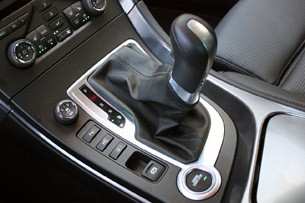
We sampled both the front-wheel drive 2.0-liter turbocharged four-cylinder 9-5 (due this Fall as a 2011 model) and the fully accoutered, grips-at-all-fours Aero XWD flagship, and they both have similar interiors with one distinct difference: the seats. In the 'base' car, we found the buckets to be comfortable enough, albeit a bit short on lateral bolstering. The Aero receives significantly better furniture – its front seats manage to have much more robust lateral support while being supremely comfortable – and there's a bottom cushion extender for those long-of-leg. We think that Saab should offer these seats to 9-5 intenders regardless of how many cylinders and driven wheels they choose to pay for. After telling nearby officials as much, a flurry of subsequent conversations and smartphone emails would appear to indicate that they're at least open to making them an option.
We noted plenty of space up front, and rear-seat legroom is positively mammoth, although that gracefully lilting roofline and a rather high bottom cushion means that headroom is limited for taller folks, and ingress and egress is a head-stooping affair (although not to the level of a Mercedes-Benz CLS). Tri-zone air-conditioning is an option, as is a twin-screen DVD entertainment package, so rear seat occupants should have few objections, even on longer trips.
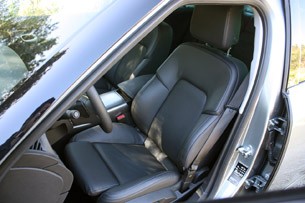
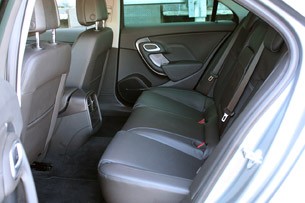
One final recommendation: As appropriate as it might seem for a company steeped in aeronautics, skip the heads-up display if you can. While it imparts a wealth of useful information, we noted significant and distracting glare from the HUD's housing (cue additional executive conversations and emails). A fix is promised, and unlike the red-tape laden bureaucracy at GM, we actually believe an adjustment will be made in a timely fashion, so consider this a temporary warning.
But enough about the furnishings – how does it drive? We exited the parking lot at Gothenburg-Landvetter airport aboard a front-drive 2.0T six-speed manual transmission model and immediately felt at home. Despite being a large car, the 9-5 "drives small" – and not just when pushed. Even at everyday commuting speeds, its easy responses and good visibility make it feel significantly tidier of dimension – perhaps Volkswagen Passat-sized. There's none of that artificial forced heaviness that has creeped in to some Germanic rivals, but that isn't to say that the steering is featherweight, the brakes are soft or the gearbox is loose. On the contrary, the inputs are well judged, with a nicely weighted clutch with linear engagement, a gearshift that's orders of magnitude better than that of previous Saabs and a right-sized steering wheel that offers good precision and communication from the hydraulic rack-and-pinion setup beyond the firewall.
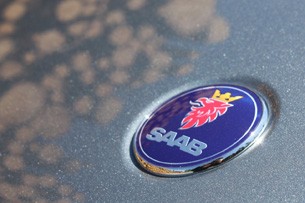
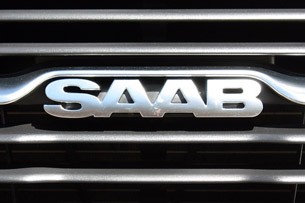
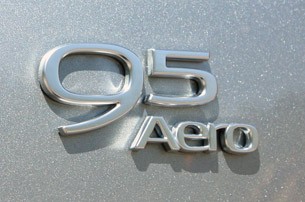
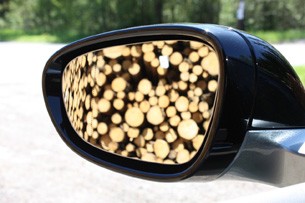
The direct-injected twin-scroll turbo four produces 220 horsepower at 5,300 rpm and 258 pound-feet of torque at 2,500 rpm, meaning that there's a slightly longer delay in reaching peak power than we've come to associate with some new DI engines of similar size. From where we sit, this is actually a source of entertainment and differentiation, as it subtly reminds us of Saab's 'big thwack' forced-induction heritage without resorting to actual massive turbo lag. Indeed, also unlike force-fed Saabs of yore is the conspicuous absence of torque steer, even with a conventional MacPherson strut front suspension on the base model. Saab indicates 0-62 mph arrives in 7.9 seconds, but surprisingly for such a small displacement engine toting a super-sized body, it feels a bit quicker than that, and it's good fun hearing the turbo whistle blow while keeping the engine in its powerband. Keep the throttle planted and the four-cylinder will run to 149 mph, with the V6 pushing to 155.
Regardless of how many cylinders you specify underhood, you can also get Saab's new DriveSense adaptive handling – it's standard on the V6 Aero and optional on I4 models. Basically, it's a three-position dial on the center console that optimizes the car's various systems for tailored ride and handling. Damping rates, steering weight, shift points and throttle mapping are all tailored to one of three modes Comfort, Sport or Intelligent. The first detent allows for more suspension compliance and a relaxed throttle for maximum fuel economy. The middle setting curbs power steering assist, raises shift points, makes throttle control more urgent, stiffens the dampers and, critically, sends more torque to the rear-wheels. As you might suspect, the third mode, Intelligent, seeks to find the best balance between the other two settings, and it succeeds. Of course, if you think you know better than Saab's engineers, it's also possible to alter the system's individual parameters through the touchscreen.
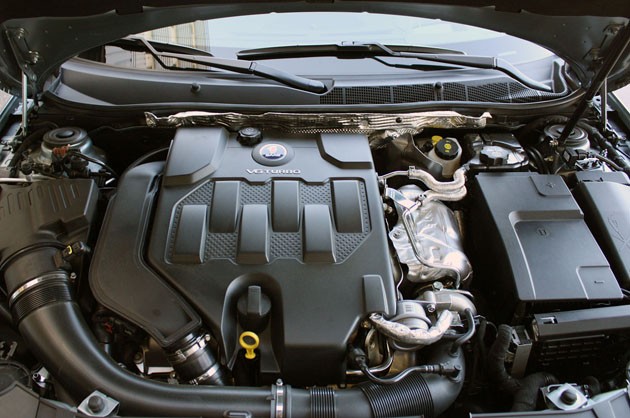
We didn't have the chance to sample a 9-5 without this trick bit of siliconry, so we'll need to try DriveSense on a wider range of road conditions to really judge its merits. Sweden has a beautiful network of rolling B-roads that threads through its densely wooded interior (it's not entirely unlike the Pacific Northwest), but its roads are in such good repair that we didn't get the opportunity to feel how it behaves over buckled pavement. Interestingly, we understand from Saab's engineers that the standard four-pot's setup is oriented toward a more sporting experience, so even though DriveSense appears to work as advertised, we suspect the base front-driver might be just as well without it. In fact, less supportive seats aside, we actually prefer driving the four-cylinder 9-5 to the Aero XWD.
It's not that there's anything wrong with the 300 horsepower (at 5,500 rpm), 295 pound-feet of torque (at 2,000 rpm) turbo V6. We've loved the torque-vectoring all-wheel drive since we first sampled it in the 9-3 Turbo X, and the six-speed automatic is largely commendable in its smoothness, although we do wish the paddle shifters worked when the gear lever was left in 'D.' Overall, the Aero may be more accomplished, but it's also not as engaging, in part because the addition of power and an automatic gearbox encourages less interaction from the driver and in part because at 4,464 pounds, it's significantly heavier than the 2.0T (3,472). While certainly not out-of-line for its class (particularly given its massive equipment list and all-wheel drive), the Aero's weight and grippier Haldex setup mean that it just doesn't feel as tossable as its FWD counterpart, even with its standard 'sport chassis' setup that includes a bigger front anti-roll bar, stiffer springs and a 10 mm lower ride height. Interestingly, V6-equipped models utilize a totally different suspension setup than the four-cylinder model, one that includes GM's new HiPer strut front suspension and a linked H-arm setup out back.
Rounding off the more polished V6 model is a note about noise: The 2.8 is seriously quiet – almost too quiet. With a quoted 0-62 mph time of 6.9 seconds, it's the quicker car, but if you're really that concerned about off-the-line snap, there are swifter offerings in this class. In short, the 2.8 Aero is a really fine cruiser, and it's the better bet for inclement weather, but enthusiasts would do well to sample the front-drive four-cylinder model first.
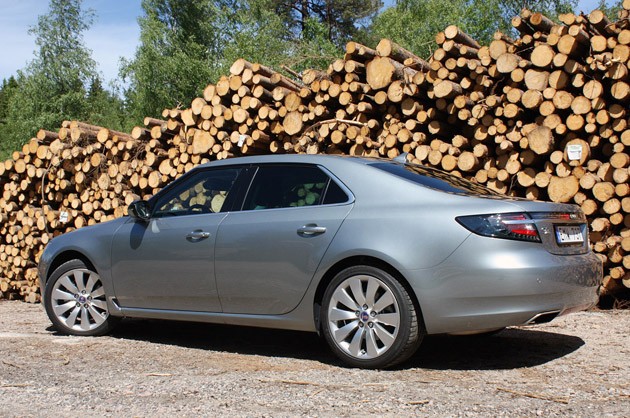
As a bonus, the four-equipped 9-5 figures to be much less expensive. Saab has already stated that the 9-5 Aero will retail for $49,995, and at first glance, the Aero seems to be priced uncomfortably close to that of its more prestigious European rivals – the Audi A6, BMW 5 Series and Mercedes-Benz E Class all start in the same neighborhood. But it's important to note that at that price the 9-5 comes loaded to the headliner with features like sat-nav, moonroof, lane-departure warning, active bi-xenon headlamps, park assist, heated and cooled leather seats, iPod integration, 19-inch wheels and a heads-up display – all items that can easily add another 10 grand to its competitors' bottom lines. If you want to go for the full Saab smörgåsbord, there's the aforementioned tri-zone HVAC and rear-seat entertainment packages, Harman/Kardon audio, along with some rather nice (if unnecessary) Brembo brakes that we sampled on a test track (what's a Swedish car launch without the obligatory 'moose test'?). Oddly, the bigger binders actually require downsizing to a unique 18-inch alloy, as they don't fit under the turbine 19s. Alternatively, we understand that the base 9-5 2.0T will retail for somewhere in the neighborhood of $38-39k, and even with a few options, this package strikes us as a much more compelling buy, pricing out against much smaller cars like the A4 and C Class.
In our interactions with Saab's new leadership, we were pleased to find that they have a rich appreciation for what the Scandinavian brand stands for – and just as importantly, a plan for what it can and should be. While it's clear that Muller and company don't view theirs as a brand that should be all things to all people, the wider market seems to be finally cottoning on to many of Saab's traditional strongholds, placing an increasing emphasis on small-displacement engines, forced induction and foul weather performance. That bodes well for Saab's strategy to find profitability not by blending in with the mainstream, but by sticking to its oddly endearing knitting. After a belated birth following much disorder and chaos, the new 9-5 paints a promising future for Saab, and we can't wait to see what it can develop as a fully independent company. Skål!
Photos by Chris Paukert / Copyright ©2010 Weblogs, Inc.
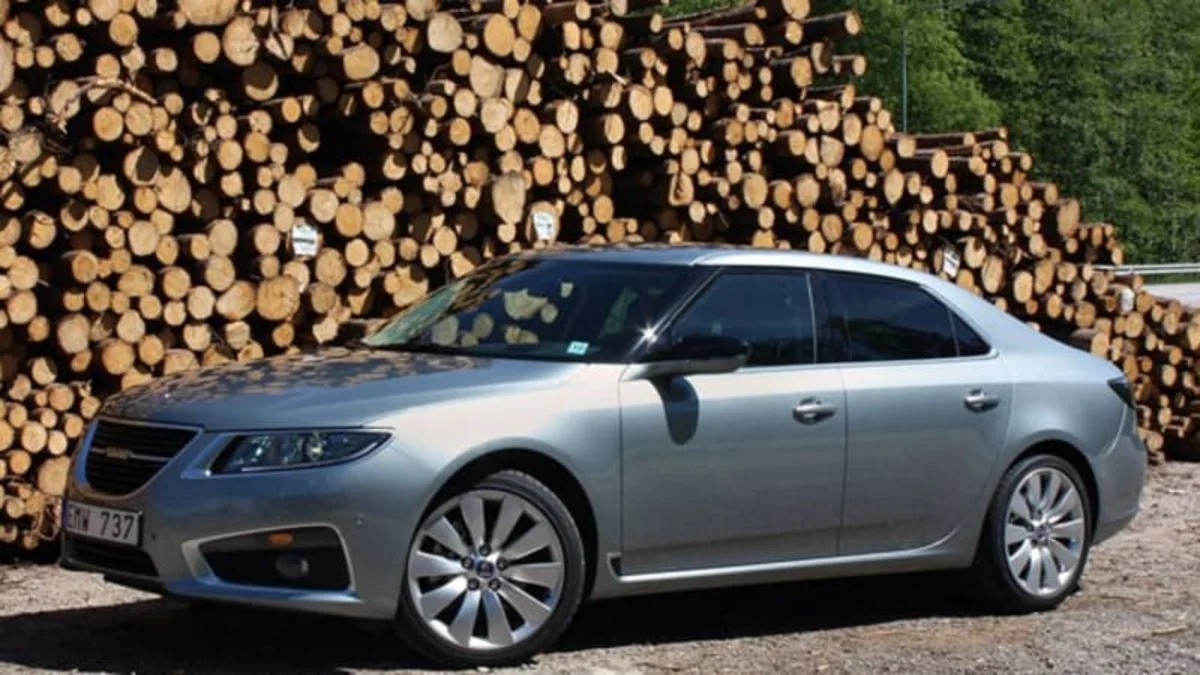
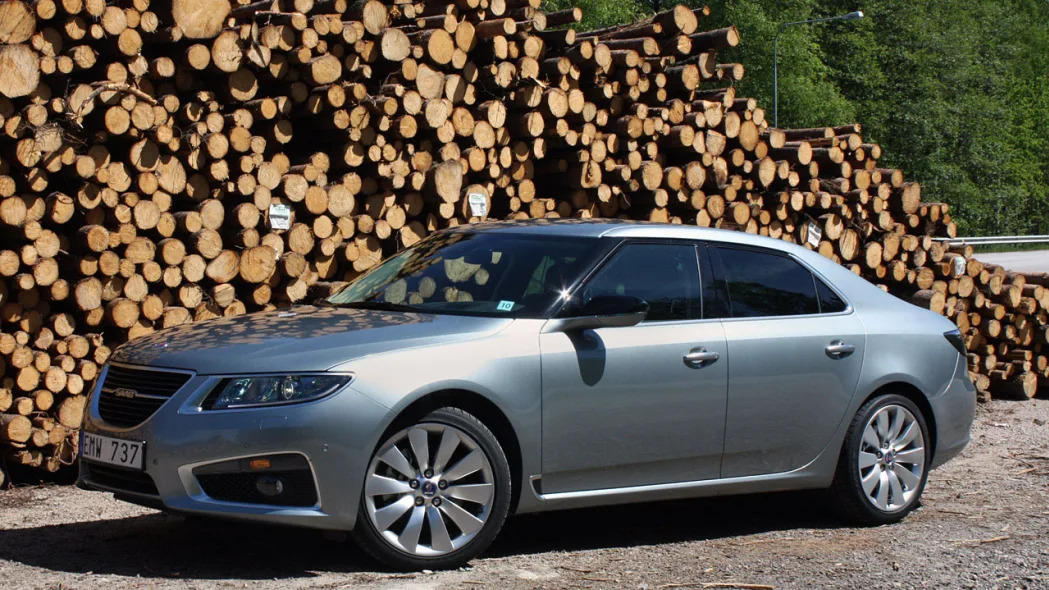
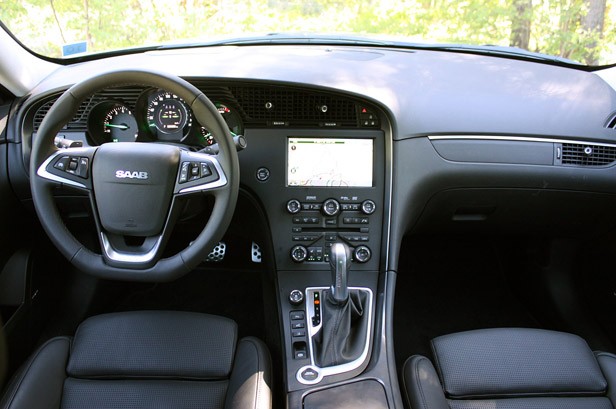
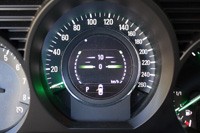
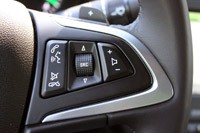
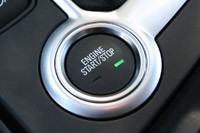

Sign in to post
Please sign in to leave a comment.
Continue